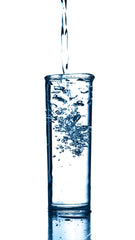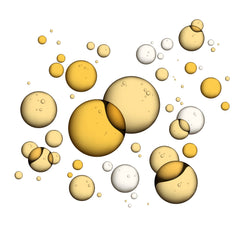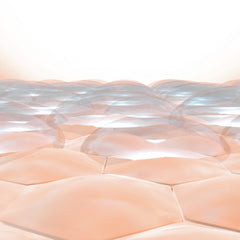The Scoop
What's the difference between a humectant, emollient and occlusive, and which do I need?
by Kate Grant
A year ago

Is My Skin Dry or Dehydrated? What's the difference, and what products should I use?
First, it's essential to understand that there is a difference between dry and dehydrated skin. Dehydrated skin lacks water (usually caused by diet or environmental factors). You will need to rehydrate it with ingredients that help it hold on to water molecules. Dry skin lacks oil because it produces less sebum, meaning it doesn't have enough fatty lipids to retain its protective barrier. You will need to replenish your skin with products rich in oils and ceramides. "Dry skin" is an actual skin type, while "dehydrated skin" is a temporary condition anyone can experience – even those with oily skin.
An easy way to tell if you have dry or dehydrated skin is to evaluate the texture and color. Dry skin will look flaky or patchy and often has redness, while dehydrated skin will feel tight and have a dull appearance.
What is the difference between a hydrating product and a moisturizing product?
The most straightforward explanation is that hydrators (humectants) bind water to the skin, whereas moisturizers (emollients or occlusives) create a protective barrier that locks in hydration and prevents water loss.
Let's dive a little deeper here to help you get a better understanding.
Hydrators (humectants) bond with the water molecules from various environmental sources and hold them in the skin's surface, leaving it plump and hydrated. Humectants can be great, especially in humid environments, where they can easily pull moisture from the air into the skin. There is a caveat: you may want to steer clear of this type of product if you live somewhere dry. Equally, during the winter months, when there is low humidity, as humectants can pull moisture from the deeper layers of your skin, causing an adverse effect. The most common hydrating heroes are Hyaluronic Acid and Glycerin.
Moisturizers help lock in hydration and keep the skin from drying out. The skin has a protective lipid barrier consisting of natural oils. This barrier is there not only to help keep water in your skin but to keep environmental toxins out. When the skin gets dried out, this protective barrier starts to break down and becomes unable to do its job, which creates dry, irritated skin with more pronounced wrinkles.
Moisturizers are broken down into two categories: occlusives and emollients.
Occlusives are moisturizing ingredients that create a physical barrier on the skin to prevent transepidermal water loss and lock in hydration. Occlusives come in the form of petroleum jelly (Vaseline), mineral oil, silicone, dimethicone, waxes, and lanolin.
Emollients are moisturizing ingredients that soften the skin, help keep it supple, and decrease inflammation, so the skin feels more comfortable or less itchy. Emollients include butters, oils, esters, lipids, and fatty acids, all of which have some occlusive properties but are known to help rebuild skin barrier function and prevent dry skin.
Should I use a humectant, emollient or occlusive?
Humectants are great for people with oily or acne-prone skin, as they don't leave any sort of film on the skin and therefore won't run the risk of clogging pores. Hydrating products are also great for people looking to plump up sagging skin or fine lines. We recommend using them with caution during dry winter months, especially if you struggle with dry skin, as they may make the problem worse by pulling hydration from the deeper layers of the skin towards the surface where it will evaporate.

Hydrators / Humectants:
- Oil-free, water-based products.
- Hyaluronic Acid Serums and Glycerin are prime examples of good hydration products.
- Bind water to the top layers of the skin to plump the look of wrinkles.
- All skin types need hydration – especially great for acne-prone skin.
Emollients work well on all skin types and can be used on both the face and the body. Dry or sensitive skin will greatly benefit from emollients ability to help strengthen the skins fatty lipid barrier – especially if you are using potent anti-aging actives like Retinols, AHA's, BHA's, or Vitamin C. Lightspeed Hydra Glow C Serum combines the best of both worlds: clinical strength Vitamin C in a Squalane Oil base to help moisturize the skin and prevent irritation that can often occur with water-based vitamin c products.

Emollient Moisturizers:
- Oils or fatty lipid-based products that help lock in hydration and enhance the skin's protective lipid barrier.
- Lotions, Creams, Face Oils that are rich in ceramides and fatty acids
- All skin types need a moisturizer – especially at night and in the winter months.
Occlusives are suitable for people with extremely dry, irritated skin or those suffering from skin conditions such as eczema. Because they create a physical barrier on the skin, they can clog pores and cause breakouts if skin is already oily or if the product is applied too thick. Occlusive moisturizers are particularly helpful during the dry winter months; dry air increases the rate of transepidermal water loss (a fancy way of saying it pulls water out of the skin), causing it to be dehydrated. The physical barrier that occlusives create helps to prevent water loss and aids in strengthening barrier function.
The most common occlusive is Petroleum Jelly (the main ingredient in Vaseline). Occlusive products have seen a revival as they help combat dry, flaky, or irritated skin. The K-Beauty viral trend "nighttime slugging" or "slug life" is taking on new heights as more and more people are experiencing sensitized or irritated skin as a result of overuse of highly active, treatment focused skincare such as Retinols, AHA's, BHA's, and other exfoliating ingredients. New York based Dermatologist Dr. Angelo Landriscina explains in an interview with Byrdie that "slugging prevents most transepidermal water loss which allows the skin to rebuild its moisture barrier, in turn improving the overall skin condition once the product is removed."
Petroleum Jelly is non-comedogenic, but that does not mean that it is right for every skin type. If you have oily or acne-prone skin, you will want to steer clear of the slugging trend and stick with humectants and/or emollients.

Occlusive Moisturizers:
- Occlusives form a physical barrier on the skin to prevent water loss.
- Petroleum jelly, Aquaphor, Lanolin, Silicone, and Wax
- Extremely dry or irritated skin types need an occlusive moisturizer – especially at night and in the winter months.
We often recommend a combined approach when deciding which type of product to use. Hydrators or humectants are perfect for layering under emollients, as they provide the skin with a surge of hydration, then you seal it all in with an emollient moisturizer and an occlusive if your skin is really dry. Not sure which order to apply your skincare? Read this.
Skin is a living organ that is affected by many factors, including diet, stress, environmental changes, etc. It's essential to reevaluate your skincare needs accordingly and use products with ingredients which work together to help you achieve and maintain optimum skin health.
Want more tips on how to winterize your skin or transition your skincare routine from summer to winter?

1 comment
Great article!! Thanks. My skin is definitely dry. Lightspeed HELPS my face so much..
But the rest of my body is a DRY DISASTER!!!